By Lawrence Haywood, Mar 17, 2025
A budding rivalry is growing in the land of ancient dragons. Vietnam’s northwest region is giving rise to a new legend, one that looks and feels exactly like internationally acclaimed Halong Bay, but without the big tourist numbers that have marred experiences of its beautiful limestone scenery.
What divides the two regions of Halong and Lan Ha bays is an invisible line through an innocuous stretch of calm water between rugged cliffs, where a large group of boats on one side and a small group on the other is the only indicator of the line’s existence. As knowledge of the unknown bay grows, the question of Halong Bay or Lan Ha Bay begins to enter to the minds of tourists coming to Vietnam in search of the most tranquil experience in the UNESCO-recognised region. We look at different aspects of both bays to answer this emerging question.
|
Halong Bay |
Titop |
Bai Chay |
Tuan Chau |
Soi Sim |
|
Lan Ha Bay |
Ba Trai Dao |
Cat Co |
Tung Thu |
Van Boi |
Allegedly, there are 139 official beaches in Lan Ha Bay. How many any of these constitute about 100 grains of sand wedged between pebbles is anyone’s guess, but there’s no denying that, for quantity at least, Lan Ha matches Halong Bay on one of its top attractions and an unmissable feature of every itinerary in the gulf. The quality, however, varies substantially and people choosing Halong Bay or Lan Ha Bay often focus on the beaches first.
Though Halong Bay has the projected picture of untouched beaches hemming the sides of rocky outcrops, this image has sadly been lost among tourists. Well, actually, they still remain but are far removed from the strict itineraries that visit one of the small selection of beaches that the government makes accessible to tourists.
Titop Island features one such beach, and as a result, can get some serious traffic during the peak season. The panoramic view it offers from the top echoes the one found at Soi Sim Beach, but, while still developed, Soi Sim retains an aura of the unknown, probably owing mostly to its very recent establishment and the appearance of the charming thatched-roof umbrellas that provide a lot of shade.

Titop Beach
Likewise, of the ‘139’ beaches dotted throughout Lan Ha Bay, very few allow guests from cruises, but the sanctity that you can find on the shores of even its most populated beaches is still one that may not be found in Halong Bay. That is if you ignore the trio of Cat Co beaches 1, 2 and 3 on Cat Ba Island; these see a ridiculous amount of Vietnamese tourists on their tiny spits of sand and should be avoided.
Ba Trai Dao is one of the most charming beaches in Lan Ha Bay, even coming with an interesting local legend to explain the appearance of the three plump rocks that give the island its name (Ba Trai Dao = Three Peach Island). The island enjoys relatively low tourist numbers and some of the most untainted sands and waters you’re likely to find on the accessible beaches.
Tung Thu is another quiet offering on the south coast of Cat Ba Island, while Van Boi presents the opportunity for snorkelling and taking in the views of colourful coral reefs below the emerald surface.
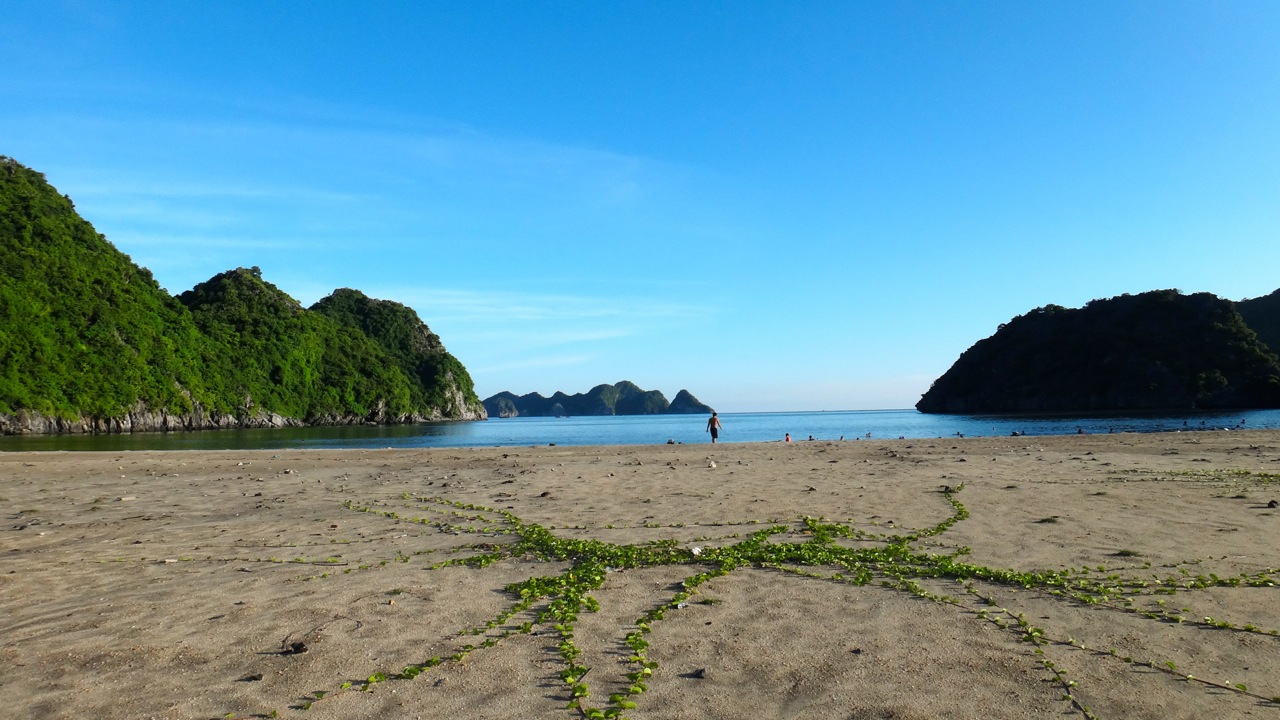
Tung Thu Beach
>> Halong Bay or Lan Ha Bay?
Some suggestions of cruises that go to Halong Bay:
|
Halong Bay |
Sung Sot |
Thien Cung |
Trong |
Trinh Nu |
Dau Go |
Luon |
|
Lan Ha Bay |
Dark and Bright Caves |
Hospital |
Trung Trang |
Thien Long |
|
|
Halong Bay’s caves are famed throughout the country for the elaborate legends attached to some of the more interestingly shaped rocks inside. While they outnumber Lan Ha Bay considerably (we could have mentioned more above but we don't have space), we have to assess other factors like uniqueness, history and beauty when deciding between Halong Bay or Lan Ha Bay.
Fortunately for Halong Bay, it has all of these in abundance. Sung Sot is the paragon of uniqueness and beauty for its huge cavernous areas dotted with stalactites and stalagmites lit up in colourful lighting. Thien Cung and Trinh Nu are also known for their beauty, while Luon is Halong Bay’s most stunning wet cave, through which tourists row to find a secluded lake. For history, it’s hard to find one as rich as Dau Go (Cave of the Wooden Stakes), which served as a pivotal place to stockpile the wood that would be sharpened and placed in huge spiked stakes that would end up preventing the Mongol invasion in the 13th century
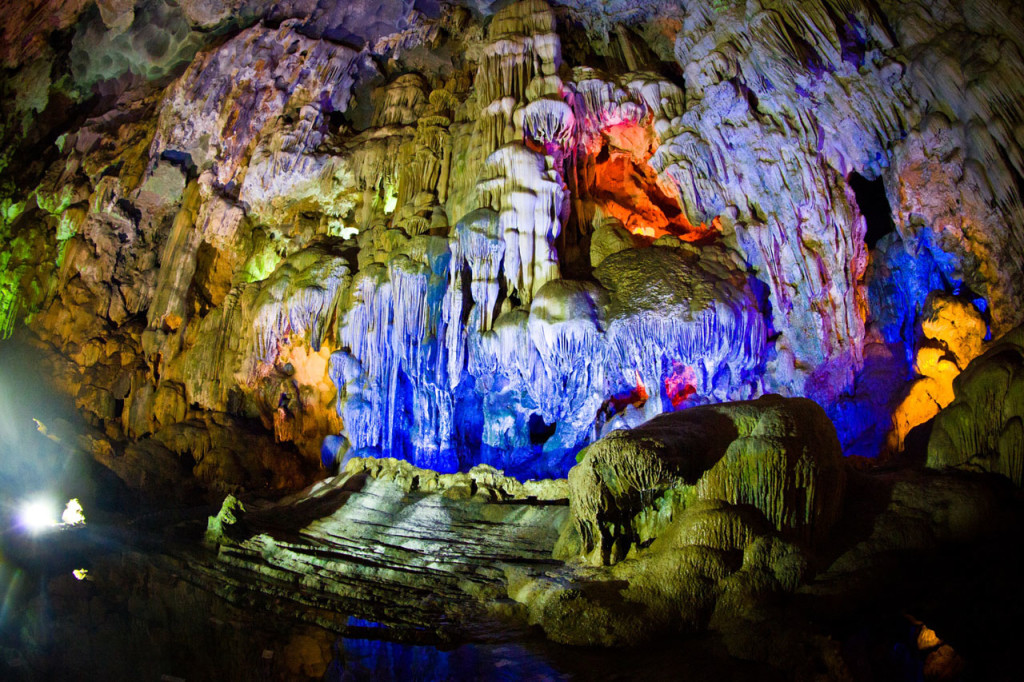
Thien Cung Cave
Lan Ha Bay’s caves lie almost exclusively on Cat Ba Island, except for its most naturally interesting, the Dark and Bright Caves. The two opposing caves differ, as their names suggest, in the amount of light entering from outside; the dark cave is long and therefore requires torches for exploration, while the bright cave is really just a short corridor that opens up onto a wonderful lake enclosed by stretching limestone cliffs.
The Hospital Cave is Lan Ha Bay’s most interesting cave historically, as its large caverns made it the perfect place to take care of the injured Viet Cong soldiers during the American War. The cave was very difficult to find from the ground and the air, making it the perfect place to rest up troops, plan attacks and relax in the rather lavish swimming pool and gigantic cinema.
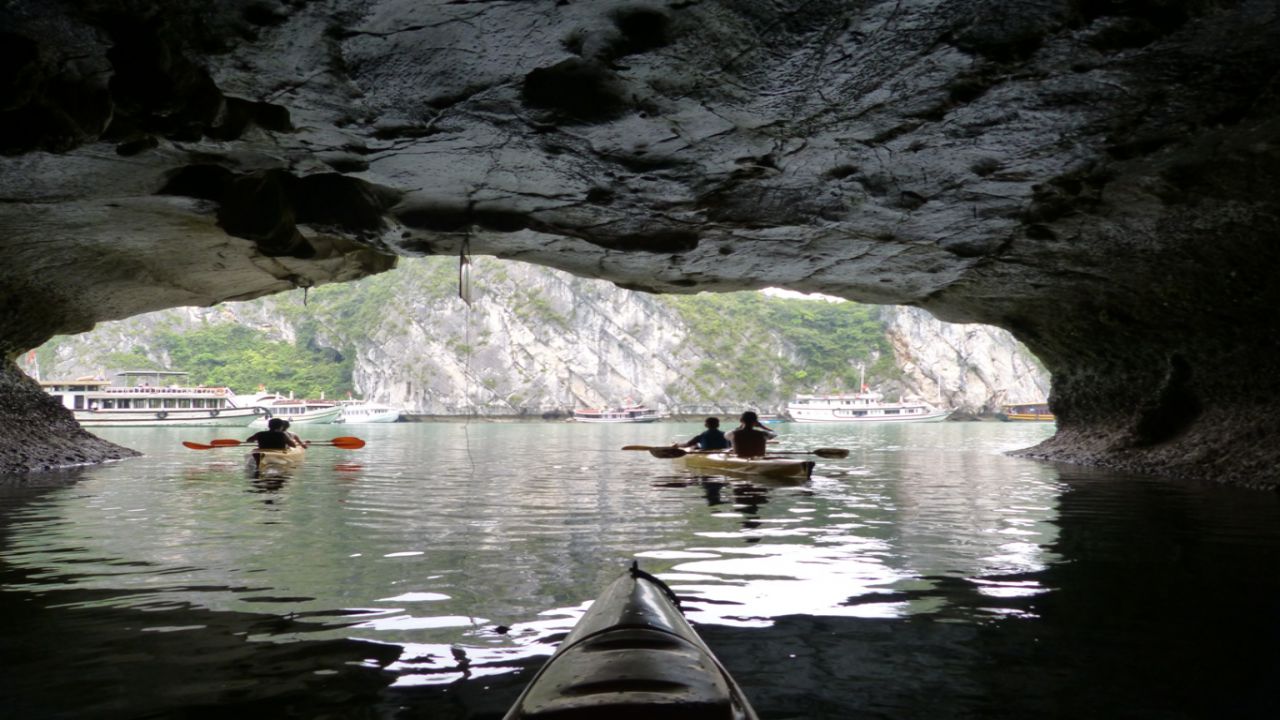
Dark Cave in Lan Ha Bay
>> Halong Bay or Lan Ha Bay?
|
Halong Bay |
Cua Van |
Ba Hang |
Tung Sau |
|
Lan Ha Bay |
Cai Beo |
|
|
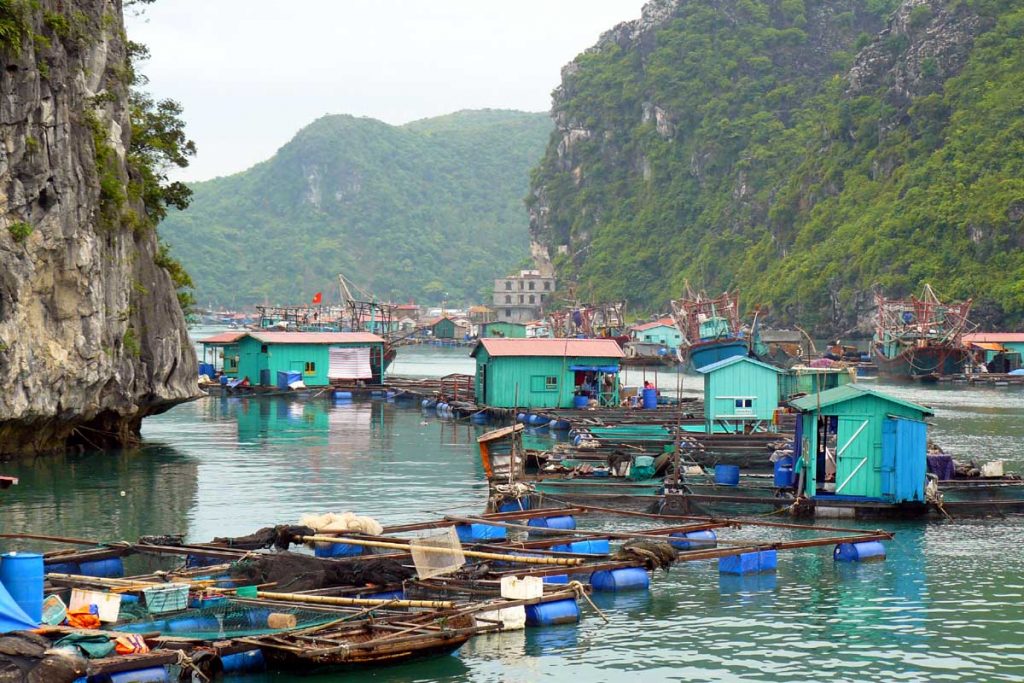
Cua Van Fishing Village
While plenty of tiny communes accompany the coastline of Cat Ba Island, Cai Beo is the only one big enough to call itself a village. Excavations in the hills around Cai Beo in 2006 unearthed much evidence of ancient trading, suggesting that Cai Beo was in existence and connected with other villages and the mainland for about 4,500 years. You can see the stretch of Lan Ha Bay’s fishing villages at the lookout point at Cannon Fort, but many of these are inaccessible and locals are rightfully left in peace. Hardly any cruises stop at Cai Beo, so visits will be from Cat Ba Town, from which you can get a taxi and ferry towards Monkey Island.
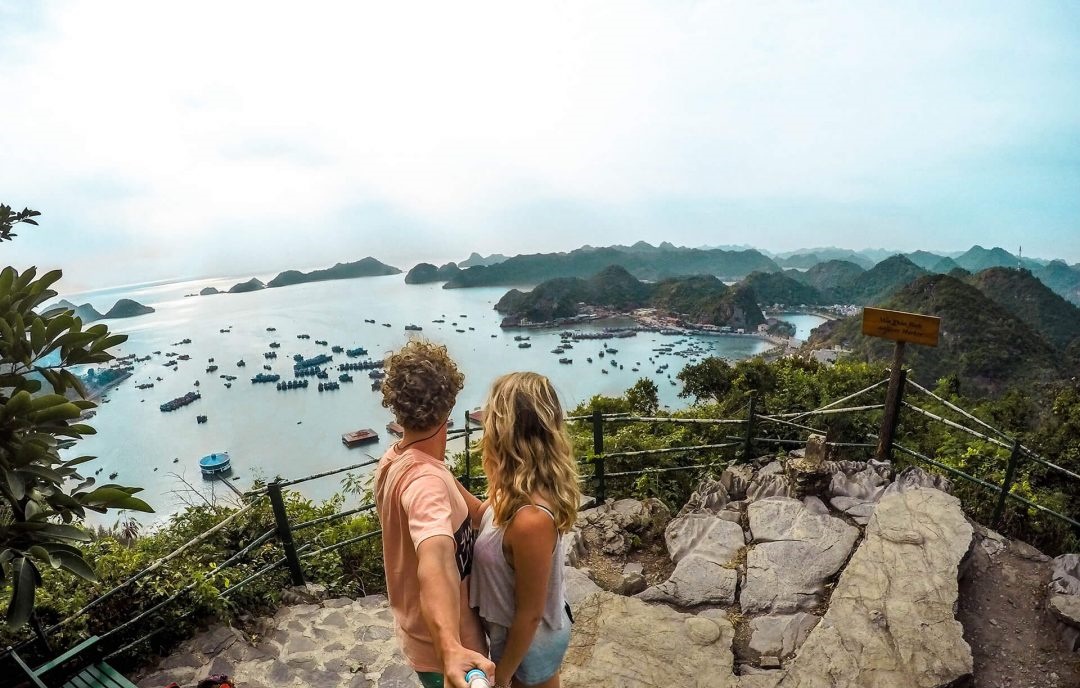
View from Cannon Fort
>> Halong Bay or Lan Ha Bay?
Check out the top-rated & best Halong Bay cruises:
|
Halong Bay |
Cua Van and Tung Sau |
Luon Cave |
Hang Ho Dong Tien |
|
Lan Ha Bay |
Ba Trai Dao |
Tra Bau |
Viet Hai Village |
The landscapes of both bays make them ideal for water sports, of which relaxed kayaking is the most popular. Almost every tour itinerary in Halong Bay or Lan Ha Bay has a kayaking option, including day trips, who realise the importance of getting close to nature from a plastic canoe.
For Halong Bay, there are plenty of areas to go kayaking, so none get particularly crowded even when the bay is awash with tourist boats.
Places mentioned before such as Cua Van Fishing Village, Luon Cave are some of the best spots to go kayaking as they provide some of Halong Bay’s most unique and beautiful views. Places like Ho Dong Tien offer the serenity that some tourists perceive to have been lost entirely from Halong Bay, but a 30-minute kayaking session around this magical area, called ‘Fairy Lake Cave’ in English, will be enough to convince them otherwise.
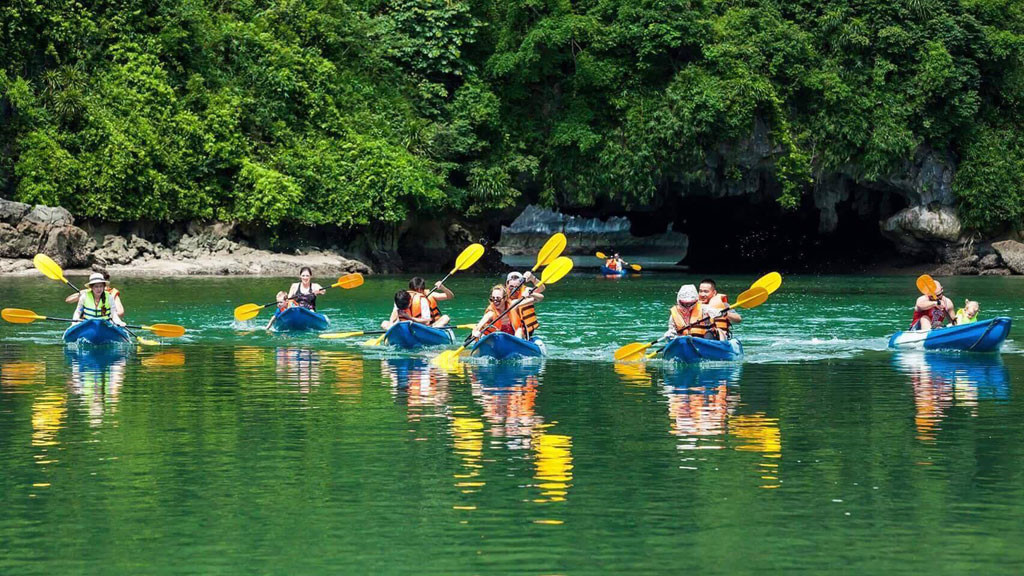
Kayaking in Halong Bay
Paddling around the peaches at Ba Trai Dao (Three Peach Island) will certainly be an awe-inspiring activity. As well as paddling around Tra Bau, a very quiet area where large kite birds fly solitarily above and mountains slope high out of the waters in diligent silence. On a 3-day, 2-night tour of Lan Ha Bay, the second day will be spent at Viet Hai Village on Cat Ba Island, an antique community living close to waters that provide excellent kayaking opportunities and the chance to get right up to the limestone walls around.
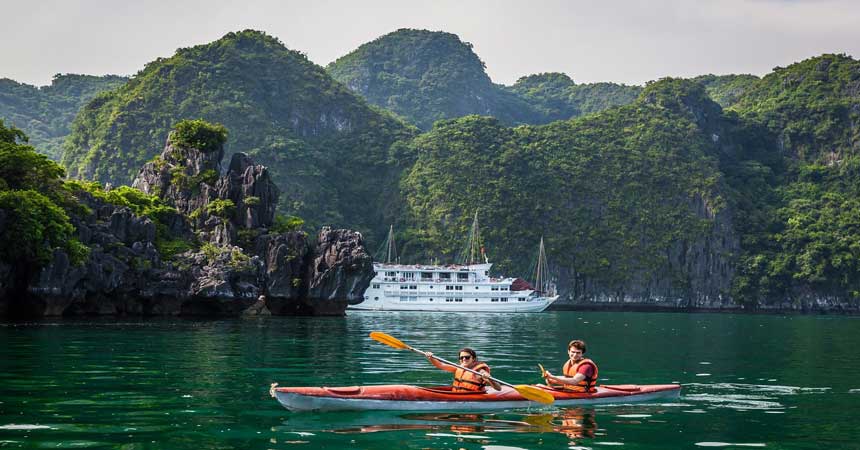
Kayaking in Lan Ha Bay
>> Halong Bay or Lan Ha Bay?
The unremitting flow of tourists into Halong Bay is well-known, and potential visitors often face the dilemma of Halong Bay or Lan Ha Bay to find the most peace on a cruise.
It’s hard to see any victory for Halong Bay here. Tourists regularly like to complain about the vast numbers of people just like them who come to Halong Bay to do the same thing as them at the same time. Halong Bay can indeed get crowded, especially at the hotspots like Titop Island and Sung Sot Cave, but the bay is enormous and there is much tranquillity to find.
Day trips to Halong Bay from Hanoi can sometimes crowd the scene a bit around the bay’s heart, but the real serenity sets in after the sun goes down and the day-trippers head back to the capital. To maximise the calm atmosphere, as well as take advantage of great discounts, research Halong Bay’s weather and head during the off-season, where rains may feature but usually for short periods in between hours of bright sunshine.
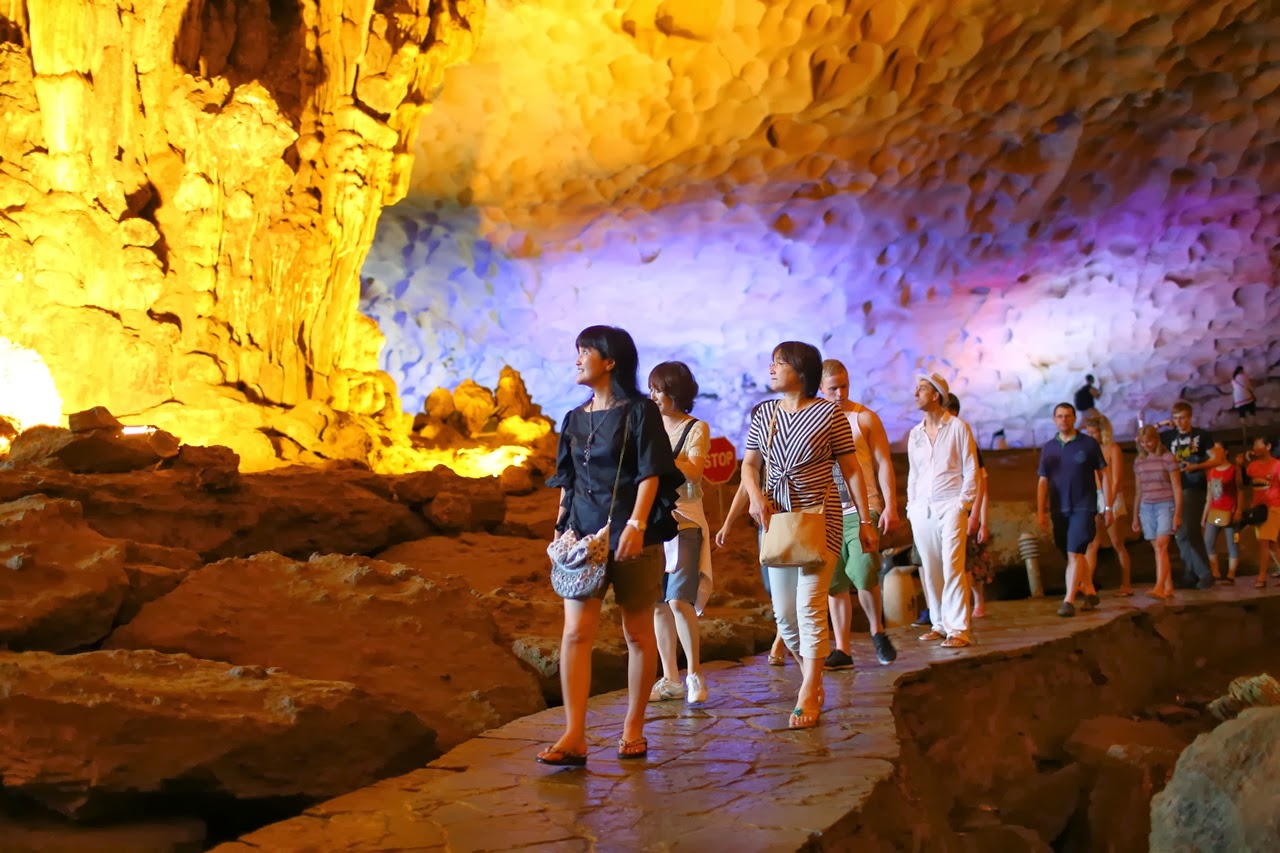
Tourists in Sung Sot Cave
Lan Ha Bay’s biggest selling point is that it looks exactly like Halong Bay but without the tourists. Currently, this is true, but many tour companies are entering the market after Quang Ninh province stopped new companies from starting cruises in Halong Bay and Bai Tu Long Bay, leaving Lan Ha Bay as the only attraction in the Gulf of Tonkin to develop. Work is continuing on a much larger harbour as Hai Phong province prepares for the armada of cruise ships that will soon arrive. Now is the best time to see Lan Ha Bay, where waterways are presently much, much quieter than its neighbour to the north.
>> Halong Bay or Lan Ha Bay?
Two for Halong Bay, two for Lan Ha Bay and a tie at the end; seems pretty even overall. When deciding between Halong Bay or Lan Ha Bay, it’s important to prioritise what it is you want out of your visit. If you would like a wealth of activities with many places to visit, then Halong Bay has more for you, but anyone seeking a quiet and contemplative time in the Gulf of Tonkin should choose Lan Ha Bay, with its quiet waterways and more secluded and authentic fishing villages.